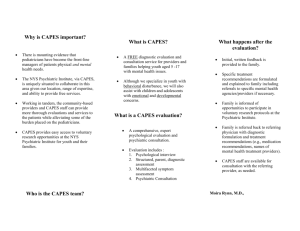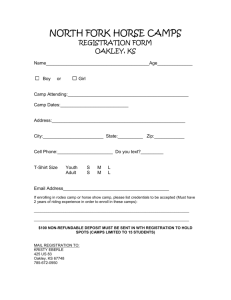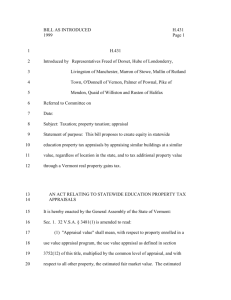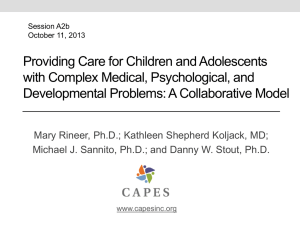Ingemar A.E. Hulthage and Iain ...
advertisement
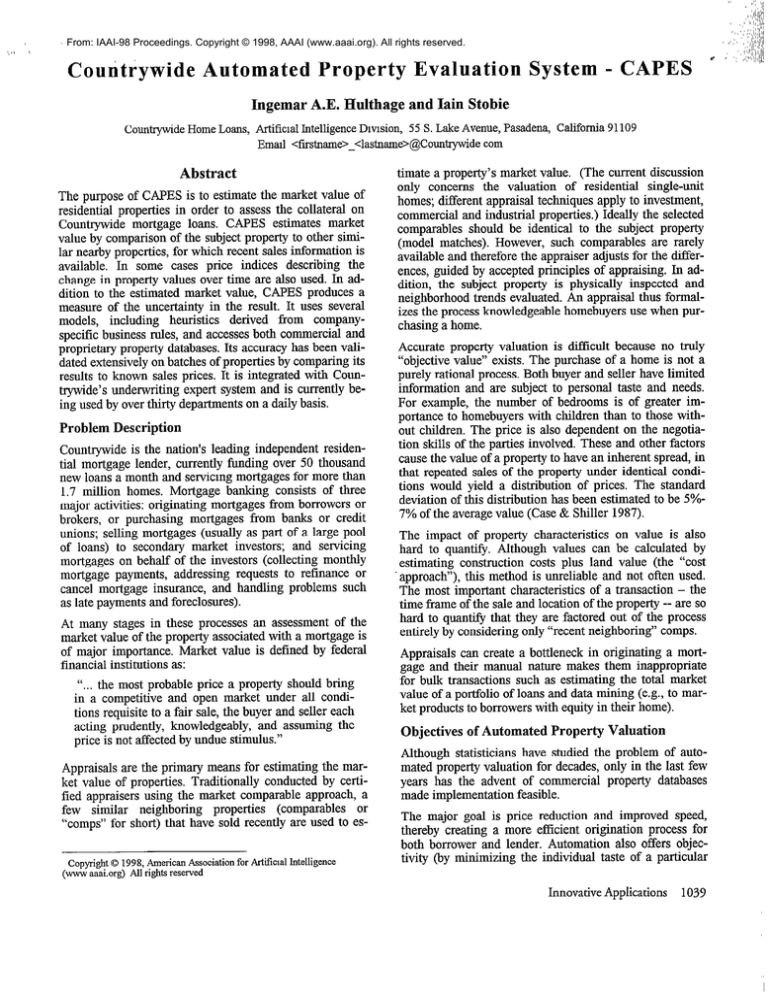
From: IAAI-98 Proceedings. Copyright © 1998, AAAI (www.aaai.org). All rights reserved. Ingemar A.E. Hulthage and Iain Stobie CountrywideHomeLoans,Artificial IntelligenceDivision, 55 S. LakeAvenue,Pasadena,California91109 Emall <firstname>_<lastname>@Countrywide corn Abstract The purposeof CAPES is to estimatethe market value of residential properties in order to assessthe collateral on Countrywide mortgage loans. CAPES estimates market value by comparisonof the subjectproperty to other similar nearbyproperties,for which recent salesinformation is available. In some cases price indices describing the change in property values over time are also used. In addition to the estimated market value, CAPES produces a measure of the uncertainty in the result. It uses several models, including heuristics derived from companyspecific businessrules, and accessesboth commercial and proprietary property databases.Its accuracyhas been validated extensivelyon batchesof propertiesby comparing its results to known sales prices. It is integrated with Countrywide’s underwriting expert system and is currently being usedby over thirty departmentson a daily basis. Problem Description Countrywide is the nation’s leading independentresidential mortgage lender, currently funding over 50 thousand new loans a month and servicing mortgagesfor more than 1.7 million homes. Mortgage banking consists of three major activities: originating mortgagesfrom borrowers or brokers, or purchasing mortgages from banks or credit unions; selling mortgages(usually as part of a large pool of loans) to secondary market investors; and servicing mortgageson behalf of the investors (collecting monthly mortgage payments, addressing requests to refinance or cancel mortgage insurance, and handling problems such as late paymentsand foreclosures). At many stages in these processesan assessmentof the market value of the property associatedwith a mortgageis of major importance. Market value is defined by federal financial institutions as: “... the most probable price a property should bring in a competitive and open market under all conditions requisite to a fair sale, the buyer and seller each acting prudently, knowledgeably, and assuming the price is not affectedby undue stimulus.” Appraisals are the primary meansfor estimating the market value of properties. Traditionally conducted by certified appraisersusing the market comparableapproach, a few similar neighboring properties (cornparables or “camps” for short) that have sold recently are used to esCopyright 0 1998, American Association for Artificial Intelligence (www aaai.org) All rights reserved timate a property’s market value. (The current discussion only concerns the valuation of residential single-unit homes; different appraisal techniquesapply to investment, commercial and industrial properties.) Ideally the selected comparablesshould be identical to the subject property (model matches). However, such cornparablesare rarely available and therefore the appraiseradjustsfor the differences,guided by acceptedprinciples of appraising. In addition, the subject property is physically inspected and neighborhoodtrends evaluated.An appraisal thus formalizes the processknowledgeablehomebuyersuse when purchasing a home. Accurate property valuation is difficult becauseno truly “objective value” exists. The purchase of a home is not a purely rational process.Both buyer and seller have limited information and are subject to personal taste and needs. For example, the number of bedrooms is of greater importance to homebuyerswith children than to those without children. The price is also dependenton the negotiation skills of the parties involved. These and other factors causethe value of a property to have an inherent spread,in that repeatedsales of the property under identical conditions would yield a distribution of prices. The standard deviation of this distribution has been estimatedto be 5%7% of the averagevalue (Case& Shiller 1987). The impact of property characteristics on value is also hard to quantify. Although values can be calculated by estimating construction costs plus land value (the “cost . approach”), this method is unreliable and not often used. The most important characteristicsof a transaction - the time frame of the sale and location of the property -- are so hard to quantifl that they are factored out of the process entirely by consideringonly “recent neighboring”camps. Appraisals can create a bottleneck in originating a mortgage and their manual nature makes them inappropriate for bulk transactions such as estimating the total market value of a portfolio of loans and data mining (e.g., to market products to borrowerswith equity in their home). Objectives of Automated Property Valuation Although statisticians have studied the problem of automated property valuation for decades,only in the last few years has the advent of commercial property databases made implementation feasible. The major goal is price reduction and improved speed, thereby creating a more efficient origination process for both borrower and lender. Automation also offers objectivity (by minimizing the individual taste of a particular InnovativeApplications 1039 ~buyerlseller or pressureson the appraiser) and consistency (by minimizing individual differencesbetween appraisers). However, there are issues and aspects of the appraisal processthat automated systemswill probably never be able to adequatelyaddress.Specifically: l Property databases,usually derived from public records, cover only about half the country and can be incomplete and inaccurate. l Available databases have no reliable information about the condition of properties. The fact that a property has been constructed, improved, or even destroyed may not be reflected in available databases. l Other data (e.g., view) may be subjectiveor imprecise. l Heterogeneousneighborhoods and unusual properties pose additional problems. are sometimes called hedonic. The property information usually comes from county assessorsand recorders offices, cleaned up and repackaged by commercial vendors in electronically accessibledatabases.Another source is proprietary property and appraisal databasesmaintained by large lenders such as Countrywide. Dimensions and volume of information distinguish human from automated valuation. Human appraisers (and homebuyers) perceive broad and detailed information, including such hard to quantify features as view, condition, “flow” and “appeal,” from the visual inspection of only a few cornparables. In contrast, automated systems can review hundreds of comparablesbut have accessto only specific, limited information on each. For these and other reasons it is neither appropriate nor desirable to eliminate human involvement from appraisals. Instead, the CAPES project provides an alternative property valuation method that can be used to complement manual appraisals or in situations where the advantage of a human appraisal is less significant (Eckert et al. 1993). Countrywide has a variety of property valuation needs and Linear Regression has long been applied to this problem, modeling price as a linear function of the property features and thereby automatically determining what adjustments should be made for differences in features. However, straightforward regression fails to consistently yield accurate results, as has been repeatedly reported in the literature (Murphy 1988). The set of properties that are available for the regression analysis often is too heterogeneous (Newsome & Zietz 1992) and the technique too sensitive renuiresz --1 -_-_I tn .v mrrelntinn .,.,------v.. IR ‘swtem -~ I----_ that ---” amnnrt!: l”rrl-‘ - IR wide .._-- txncre~---- nf -- IIFC? ----, fmms an interactive appraiser’s assistant that can be tailored using expert knowledge of the neighborhood or subject property, to a fully automated expert system that can be used by novices or by a batch process. Depending on the other risk factors on the loan, a physical property inspection may still be required to double-check the accuracy of the data. Approaches to Automated Property Valuation All approachesfollow the samebisic strategy. l Define a set of significant residential property features l Collect information on these features for the subject and nearby properties l Develop a model to estimate the expected sales price of the subject property basedon the selectedfeatures l Apply the model to the subject to compute a value, and preferably an estimate of confidence in the value The approachesdiffer in the features defined as significant and the type of model used. At one extreme are “Home Price Index” models, using only sales prices and dates to calculate what amounts to the “average” price change in an area (zip code or county) over time (Case et al. 1991, Shiller 1991). Although this provides a useful “macro” model, it does not take into account improvement or deterioration of the subject over time and its accuracy decreasesthe oider the previous saies date Most modeis use additional property features, including: physical characteristics such as living and lot area, number of bedrooms and bathrooms, age, and presence of pool, garage, etc.; location identification such as street address, latitude and longitude, and census tract; and qualitative information such as view. Models that are based on property features 1040 Deployed Applications between --...--e- varishlas .--l-r-l (fnr ,--a euamnle .,‘-l-‘-l-..) the -a- nu&er of bedrooms and bathrooms). Non-Linear Regression and other variations on basic linear regression have been proposed (Do & Grudnitski 1992; Knight et al. 1993), but they involve additional assumptions or may require more input (Weirick & Ingram 1990). Neural Networks are used by some systems (Jest et al. 1994). However, the unfeasibility of learning in real-time necessitatesoff-line learning, resulting in a macro model of neighborhoods,not individual properties. Rules-based methods are a natural choice for this problem, becausehuman appraisals are based on established principles and professional guidelines, such as the “Uniform Standards of Professional Appraisal Practice” (USPAP). Although an element of judgment is often involved, these rules can be applied in a principled manner that is well described in several texts (Betts & Ely 1994). Additional expertise can be drawn from interviewing professional appraisers. A final advantage of these methods over “black box” regression and Neural Network techniques, is that the declarative representation of rules can be used to explain why the result was obtained. Application Description Countrywide’s overaii computing infrastructure is a decentralized collection of personal computers and servers connectedby local area and wide area networks. CAPES is a client / server application implemented in MS Visual C++ and based on the Distributed Common Object Model (DCOM) (Grimes 1997). DCOM simplifies the implementation of client / server applications by allowing the creation of COM objects remotely on another machine. This architecture makes it possible to create a variety of clients servedby the same server. In addition to the client CAPES also uses the C++ Standard Template Library (STL) (Stepanov& Lee 1995), a general-purposelibrary of generic data structures (such as lists and maps) and operations (such as insertion of elements and sorting). STL makes programming more productive by handling memory management and providing a framework for decomposing many programming problems. CAPES client The client application receives and displays all information on the subject property, control information from the user, and qualitative and quantitative information, including the estimated value with uncertainty and status information. Transaction accounting , CAPES Property data Datatranslation Vendor Property data Vendor communication t I I II CAPES SQL Database Figure 1: CAPES is a client/server system, where the server handles all communication with internal and external data sources. described in this paper, there is a client that interfaces with CLUES (Talebzadeh et al. 1995) and another that makes CAPES available on the Internet/Intranet. The CAPES server application runs as a service on a Windows NT 4.0 server and handles all users. The client application runs on the user machine, which may be running Windows NT 4.0 or Windows 95 (with a MS patch to support DCOM). The connection is normally made over a WAN, but can also be made via RAS. The server application is connectedvia a telnet connection over a leased phone line to DataQuick, our main present property data supplier, All property data and most results from CAPES runs (including usage statistics, error logs, etc.) are permanently stored in an SQL database.The client applications have no direct connection to the database or to the data suppliers. f’ ADUC bN Jd” ;c A~c.;molA ID uwqjuru CAPES allows a large degree of flexibility in the level of control and expertise required from the user. It begins by nm-fnrmino y”‘“‘““‘a~ I Vendor Data server Tn ncanc,.w,l 111 fjb4rL.~al The client user interface is implemented using MS Foundation Classes(MFC) and third party OCX controls. The client is a Multi Document Interface (MDI), where each subject property is assigned a separatewindow (Figure 2) consisting of five tabbed child windows (Subject, Results, Comp Selection, Market Analyses, and Messages). Each tab provides specific user interface features. 4k.m ll”lll +ha LUG c-wrr..nrl ~;l”uuU . . ..a ;n nm up 111 all object oriented style, using derived and template classes, virtual functions, etc. The data representationsare defined by classes,Much of the computation is performed by creating objects of specific classes, which encapsulate the input data, the computation or reasoning, and the result. an UUC”I1IUU” admmatir ..%I mmlmatinn V.CUUUU”Irn that UALaC wnnimca,+ALWY minimal IllllllSLIU1 -..y input and direction from the user. This mode is convenient and suitable for users without in-depth knowledge of appraisal methodology. Then, depending on the estimated uncertainty of the results, or for other reasons,userscan: l Edit the information on the subject property and control the selection of camps in detail l Evaluate the result based on detailed quantitative and qualitative output l Iteratively repeat this processand compare the results To start an evaluation, users must uniquely identify the subject property, usually by specifying the street number, name, and zip code, as shown in the upper part of Figure 2. When the Find Subject button is selected CAPES searchesthe data sourcefor matching property data and, if found, displays it on two lines, as seen in the middle of Figure 2. The lower line is the data retrieved from the data sourcewhile the upper line is the data actually used in the evaluation. The data used by CAPES is, by default, equal to the data retrieved, but the user can edit any incorrect information on the upper line. In the figure the user has changed the number of bathrooms from 1.70 (i.e. 1%) to 2.00. These lines scroll horizontally and contain additional characteristics. When satisfied that the right property has been found and that ULUC itc ICY phm-art&&r-c .dI-u”~vI~YYvY am= u-v IP UY armwntp U”VLuUt.V IP nnccihle U” y”YY’“‘v, tha CA&” IIEPT UYVl starts the evaluation by selecting the Compute button. CAPES attempts to find comparable properties and performs the steps of the automated evaluation (described below). The result is displayed on the bottom line and includes: the estimated value; a measure of uncertainty, expressedas a percentageof the value; the number of camps Innovative Applications 104 1 GLENDORACA 91741-2919 -I i 1.70 9 19 Figure 2: Au automatic CAPES appraisal only requires minimal property identification input used; the percentageof the camps that meet guidelines definedby the major funding agencies;and the model used to make the estimate. (The guidelines for camps apply to traditional appraisals,which may include as few as two camps.When CARES usesmany more camps,they are not all requiredto meet theseguidelines.) Expert users with detailed knowledge of the appraising process,or perhaps of the subject property or area, may further customize the evaluation using the functionality implementedon the remaining tabs. l l l The Comp Selection tab initially displays the filters selectedby CARES and a collection of statisticson the current camp set. A filter is a parameterizedoperator to subset collections of properties. Many simply choosean interval for a feature, e.g. 2-3 bedrooms. Using the selectedfilters and statisticsas a guide, users may modify (completelyor in part) the set of Illters that determinethe selectionof camps.This is the most important control action availableto users. The Market Analysis tab displays the camp set in a tabular format similar to the display of subject characteristicsshown in Figure 2. Expert usersmay eliminate any camp from the camp set. The Results tab displays the results of all applied 1042 Deployed Applications l valuation models. It also contains other qualitative and quantitative information to help expert users judge the reliability of the estimatedvalue. For example, if the camp set is biasedbecausemost camps are either more or less valuable than the subject,a warning messagedisplayson the Resultstab. In most such casesno value is displayedon the bottom line. The Messagestab displays error and other miscellaneousmessagesthat may be of interest to expertusers. All users are alerted to seriousfailures, such as the failure to find subject or camp data, through pop-up windows. A batch facility utilizing the automatic mode is also available. Usersinsert property identification data in a template table stored in a file. The file is read by CARES and the properties evaluatedone by one. When the evaluation is complete, results are reported in a file merging the original input with a number of columns holding the corresponding results. Once startedthis batch mode runs unattended,making it easyto evaluateportfolios of properties. CAPES server The servertop level providesthe methodsavailable to clients and controls the interaction with clients. It also coordinates finding subject and camp information and invok- ing the valuation engine. CAPES property data and translation CAPES Valuation Engine CAPES stores the raw property data from vendors and The valuation engine uses available information on the subjectproperty and a relatively large set of property sales. If possible, more than 150 comparablesales are retrieved from a commercial data vendor. The only restrictions on this initial set are that they must be fairly recent full value saleswithin a reasonabledistanceof the subjectproperty. mats into a single internal format that is used by the valuation engine A translation module implements the semanticsrequired to interpret the various representations and conventionsof these data sources. To achieve a valuation with a low uncertainty it is usually necessaryto reduce the set of camps by applying one or more filters. CAPES automatically selectsa set of filters. Communication with the data vendor is via a telnet connection over a leasedphone line. Given a set of camps, the value of the subject is estimated by several models. These models include regression and other models based on statistical analysis, as well as an adjustment model which seeks to follow the practices of appraisers. Regional home price indices are also used when historic salesprice and date information is available. These models are describedin some detail in the next section. An important issue is that information is often missing for the subject or one or more camps. Missing information is treated as a special value, rather than as zero or some ot,hAr rlefmlt ---II- _ vglne~ ._-_, and --- &e m-&k xe d&zned to ac- commodatethis. The result of each model is checked against a set of constraints to ensurethat a lack of information (or someother reason)doesnot producean invalid value. The uncertainty in each model result is estimatedas the standarddeviation in the subject property value. The model with the lowest estimated uncertainty that also satisfies the checks is returned as the estimated value. If no model satisfies the constraints,no value is returnedto the user. Model parameters Some details of the valuation models are controlled by model parametersdefined in the code or the database.The most important model parameters are adjustments for property features. An adjustmentparameter assignsa dollar value to a feature (e.g., a bathroom might be worth $1,000) based on expert knowledge, Adjustments are collected in tables and are differentiated by criteria such as price tiers and property types. User profiles A^A,.“”err c ADDC:nID td”IIU”IICILt n,.n+mlln,l h., the. ,,am.‘~ IIbbGDb L” bIuLiU “J UIVUYVL Y nc,tw,-,,+ IIvL*.“I‘~I,,-I”gon. A user table in the databasegrants privileges ranging from no accessto full access,and also contains contact and cost accountinginformation. Transaction accounting To monitor the use of CAPES and any errors that may occur, and to allow CAPES results to be reconstructed, each transaction, along with all data and results, is logged in the database. ;n+.m...nl IIILCSIULU e,.....,.a~ D”LUUbra r,m.hot;m “VI”cIUlll am-l t,-.m,rl&,aa LWAU UWLU.~,c”Y f%-,wm 1I”II. thpqp %..““I fn,-..“I Vendor communication Reasoning about property evaluation The main inference techniques used in CAPES are describedin this section. Statistical models The median or averagevalue of the filtered camp set is sometimes the best model of value. Statistics based on other sets, such as the neighborhoodor the nearestneighbors, are also of interest. Regression model The regressionmodel performs a linear regressionof the sales prices in the set of comparableproperties. Property characteristicsare used as independentparametersand the regressionfunction is used to model the value of the subject property. It is implemented with the singular value decomposition method, which is robust against missing and redundantdata. (Presset al. 1992, Jefferys 1980,198l; Lybanon 1984) Adjustment model The adjustment model seeksto follow the practices of appraisers. The known sales prices of a set of comparables are adjustedbased on differences in the characteristics of the subject and each comparableproperty. The averageof the adjustedsales prices is the value estimatedby the adjustment model. Home price indices Price indices are constructedby reviewing repeatedsales of propertiesand calculating an index value for a point in time. Given the salesprice of a property at a specific time, the value at any other time (within the period for which the index is valid) can be computed by multiplying the original sales price by the ratio of the index vaiues. To improve the accuracy a collection of indices is used, with different indices for different property types, price tiers, and areas. Best first search CAPES differs from other property valuation systemsby using heuristic searchas the core of the evaluation engine. The main principle of appraising is to select a set of Innovative Appiications iO43 “comparable” properties that have recently sold in socalled “arms length” transactions. lf the concept of comparable property was well defined, and if sufficient information to identify comparable properties was always available, there would be no need to search. The only thing neededwould be a set of rules, or constraints, to classify camps as suitable or unsuitable for a specific appraisal. erate additional nodes. However, the number of nodes is reduced by dependenciesamong the operators. For example, applying a filter limiting the living area to f 10% difference from the subject frequently yields a subsetwith all remaining comparables having the same number of bedrooms. In this case,applying the bedroom filter doesn’t produce a new node. However, experience shows that when a fixed set of criteria are applied, in many caseseither a too small or an unnecessarily large set of cornparablesis selected. (A camp set can be too large in the sense that a more accurate evaluation can be obtained from a smaller, more carefully selectedset of camps.) Further reducing the usefulnessof fixed criteria is the uncertainty of the information on the subject and comparable properties. Several characteristics, such as the condition of the property, are not captured in the public records, while other information (on the subject or one or more camps) may be missing or simply wrong. Heuristic filtering reducesthe search spacedramatically. If there are 10 commutirig filters, the search spaceis now at most on the order of 2 nodes. The number of nodes generated is also limited by the Best-First search, which is well described elsewhere (Rich 1983). Furthermore, becauseof the inherent spread in a property’s value, nothing is gained by continuing the search when a node with an error estimate below some level (e.g. 5’) is found. Finally, experimentation shows that the search can be limited to a fairly small number of nodes (e.g., 100) without increasing the average real error. As explained above, the risk of over-fitting out weighs the advantageof generating more nodes. This situation suggestssearching for a set of cornparables that optimizes the accuracy of an appraisal based on that set. If an initial set of N recent transactions in the subject neighborhood is chosen, the search spaceof all subsetsis of the order of 2n. For example, recent transactions in the ~&nhl..\,.hrw.rl u~lljLr”“llL”“u n,\~.lA ld”LuU -PO_ UlcQll nll tmnw,nt;~nc. CUB UaJIDa.~U”‘IU ;n the 111 UlU lo.+ 11 ACZDC 1& months within a radius of one half mile from the subject, In a typical suburban area this would often include more than 100 potential cornparables.The corresponding search spaceof subsetsis too large to search exhaustively; fortunately, as explained below, an exhaustive search is not necessaryor desirable. The goal of the search is to minimize the error in the estimated value of the subject property. Becausethe true error is not known, the search must be guided by an estimate of the error, such as the standard deviation of the salesprices of the camp set. However, this evaluation function tends toward over-fitting. That is, the search finds a set of properties that happen to have a small range of sales prices (and therefore generate a low error estimate) but aren’t otherwise particularly suitable as camps. The operators in the search select a subset of a given set and are therefore called filters. By using filters that systematically generate all the subsetsof the initial set, an exhaustive search has an overwhelming risk of overfitting. To reduce the complexity and minimize the problem of over-fitting we only use search operators that are heuristically well motivated. A heuristic property filter excludes properties from the camp set based on rules known by appraisers to be useful. Such rdes CI----eenerallv ---, focw --_-L on .~~nronertv T--T-~-, character&tics. _--I--.-----C_-_L_ For - __ example, assume the subject has three bedrooms and the camp set contains properties with either three or four bedrooms. Heuristic filtering based on the number of bedrooms would yield only two nodes: the original set and the subsetwith exactly three bedrooms. Other filters (basedon the number of bathrooms, living area, etc.) typically gen1044 Deployed Applications Outlier detect@ and removal The inherent spread of property prices, and the fact that the properties in a camp set are not identical implies that the prices in a camp set is a statistical distribution. It’s reasonableto assumethat this is approximately a normal distribution, However, one frequently observessalesprices that are many standard deviations away from the average. There are many possible reasons for anomalous sales prices, such as a distressedsale, a sale within a family, or extraordinary features that reduce or increase the property’s value. Such data points are often called outliers (Barnett & Lewis 1995). CAPES uses statistical criteria to remove camps that are outliers in price and other selected characteristics. Uncertainty model An important part of CAPES is the attempt to estimate the standard deviation in the estimated value. This modeling of uncertainty is based on statistical principles and including contributions from different sources of uncertainty, such as differences between subject and camps or missing information. Incomplete information The information on the subject and comparable properties is frequently incomplete. Almost any attribute can be randomly or systematically missing. Examples of systematically missing information are the availability of total number of rooms and number of bedrooms. In some areasboth attributes are provided, while in other areas only one or neither are provided. CAPES doesn’t presently utilize knowledge about such systematic differences; instead, all missing values are represented as special values (distinct from valid values) and treated appropriately. For example if the number of bedrooms is missing for the subject, no adjustments are made for the camps based on number of bedrooms. This approach has the advantage of being robust against randomly missing information while avoiding the overhead of maintaining a knowledge base of regional differences in data availability. Constraint reasoning A critical part of the valuation process is critique of the model results. There are marry rules that can be applied to a model’s results to determine weather the result is reliable or if it is more or less accurate than the results of other models. These rules are either heuristic or statistical, and are expressed in CARES as constraints, using a simple constraint propagation system (Tsang 1993) which finds the subsetof model valuations satisfying all constraints. If more than one model remains, the one with the lowest uncertainty estimate is chosen. If no model remain, a failure is reported. Application Development and Deployment Since its creation in late 1991 the Countrywide AI department has developed a number of applications (Stobie 1996). A study of selected automated property valuation systemswas done in 1995. No system allowed the degree of control that our expert users require or allowed us to use company-specific expertise, rules of business, and proprietary appraisal databases.After deciding that no commercial system met Countrywide’s broader needs the CARES project was initiated in February 1996. By July 1996 a prototype demonstrating the feasibility of the project had been developed and received the support of senior management. It focused on the core AI problem of computing a property’s value from a set of camps, using a simple user interface and commercially available dam. A full-scale development effort took place to implement a client / server architecture, access remote and internal databases,and create a user-interface powerful enough to support the functions required of an appraiser’s assistant. In parallel, the AI and statistical models were continually refined based on ongoing knowledge acquisition and experience of using the system. In May 1997 the roll out of CAPES began and has since been deployed to a growing number of departments. A Use$s Manual and periodic training sessions adequately prepare users for CAPES, while the developers themselves support the product via telephone and e-mail. In October 1997 CARES was formally demonstratedat the Mortgage Banking Association conferencein New York city. Object-oriented design and analysis together with rapid prototyping was used to develop CARES. Each time a change to the core valuation engine is proposed, it is implemented as quickly as possible and a batch test run to determine the effect of the change on the accuracy and coverageof the system. l Accuracy is measured by how closely the estimated values compare to the known sales prices, according to averageerror, averageabsolute error, maximum er- l ror, and distribution of errors. Comparison to the subject salesprice is not a perfect benchmark (because of the occasionalforced sale or other non-arms-length transaction), but we believe it is the best available. Coverageis measuredby how often a subject property is found and a final result produced. The fact that all CARES runs are archived in a database allows re-running batch tests of thousands of properties in minutes, generating statistics on the results, and judging whether the changeshave been implemented correctly and have improved performance. We are also benchmarking CARES against other valuation systems, as opportunities arise. Application Use and Payoff CARES is used by over 30 departments at Countrywide, many on a daily basis. The marginal cost of a CARES valuation (costing only a few dollars and taking only a few minutes) makes it practical for a wide variety of applications. CAPES is used to analyze the collateral value of a portfolio of loans purchased from a smaller bank as part of the “due diligence” process.BecauseCARES is statistically nearly unbiased, its average signed error is close to zero-the over-estimatescancel out the under-estimates.By randomly sampling a subset of the portfolio of loans in regions covered by our property databasesand numing the properties through CARES, a quick and reliable total value of the portfolio can be obtained. Since these properties have already been appraised, this also facilitates a focused quality control procedure: loans where the appraised value differs greatly from the CARES value are carefully reviewed. This use of CARES to review appraisals is also applied by the Quality Control, Internal Audit, and other departments. The Foreclosure department uses CARES to estimate the potential loss (the difference between the estimated property value and the balance of the loan) incurred when a loan defaults. Once a loan has been foreclosed and the property belongs to Countrywide, the Real Estate Management department uses CARES as an aid to determine a reasonablesalesprice. The challenge to using CARES for loan origination is that most investors (to whom we deliver the loans) have not yet approved automated valuation as an acceptable appraisal method. Integrating CARES (automated property valuations) and CLUES (automated credit underwriting) potentially increases the accuracy of both systems. For example, CLUES verifies that the cornparablesused by the appraiser are within a reasonable distance of the subject, that they Innovative Applications 1045 are not all more or less expensive than the subject, and that the adjustments are not excessivelyhigh. CAPES enhances CLUES by verifying the accuracy of the subject and camps used in the appraisal, and providing a second, independent estimate of value. Speed is of the essencein today’s competitive mortgage lending businessand automation is a major successfactor. With CLUES analyzing the credit history and financial ability of the borrowers to repay the mortgage and CAPES evaluating the collateral, AI at Countrywide provides a inexpensive, and increasingly accurate quick, “streamlined” approval of low-risk loans. Countrywide is considering offering this capability directly to customers, for example over the Internet. Maintenance and Planned Enhancements The CAPES development team continues to maintain and enhancethe system.Weekly meetings with experts address issuesbased on feedback from the large user base and new industry directions. The near monthly releaseof enhanced versions of the software is greatly facilitated by the use of object-oriented design, cleanly separated modules, and declarative rules. Several enhancements are planned, including more sophisticated spatial reasoning using location of the subject and maps. For example, it is currently quite possible that nearby properties are chosen as camps when in fact they are from an adjacent, but very different neighborhood. Additional data sources are required to achieve higher coverage and more detailed and accurate data. To permit valuations in less than a second, it is imperative to install these databaseslocally at Countrywide, rather than accessing them remotely via a leased line. This opens the door to using CAPES for data mining applications, such as identifying candidates from Countrywide’s portfolio of 1.7 million loans that may benefit from refinance or are in danger of foreclosure. Data mining techniques could also automate some of the knowledge acquisition, such as empirically determining the value for adjustments.For example, the value of a swimming pool in a specific neighborhood (perhaps as a function of other features) can probably be derived by comparing a number of properties in that neighborhood References Barnett, V. and Lewis, T. 1995, Outliers in statistical Data, John Wiley & Sons. Belts, R.M. and Ely, S.J. 1994. Basic Real E&ate Ap-...“:-,..I. ?,.I ,A:+:,, n&...r:,.. TT..,, yrursu‘ J1Lla4.lU”IL, rIGllLIc;G-rla~I. Case, K.E., Bradford, Pollakowski, H., and Wacter, S., 1991. On choosing among house price index methodologies.AREUEA Journal, 1991:19,286-307. Case, K.E., and Shiller, R..J. 1987, Prices of Single Family Homes since 1970: New indexes for Four Cities. New 1046 DeployedApplications EnglandEconomic Review, 1987,45-56. Do, H and Grudnitski. 1992. A Neural Network Approach to Residential Property Appraisal. The Real Estate Appraiser December 1992:38-45. Eckert, J.K., O’Connor, P.M. and Chamberlain, C. Computer-Assisted Real Estate Appraisal: A California Savings and Loan Case Study. The Appraisal Journal, October 19931524-532. Grimes, R., 1997. Professional DCOM programming, Wrox PressLtd. Jefferys, W.H. 1980. On the method of least squares. 1980,1981 The Astronomical Journal 85(2):177-181 and 86(1):149-155. Errata 95(4). Jost, A., Nelson J., Gophinatan, K., Smith C., Real estate appraisal using predictive modeling. U.S. Patent 5,361,201, Nov 1, 1994. Knight, J.R., Hill R.C. and Sirmans, C.F. 1993. Stein Rule Estimation in Real Estate Appraisal. The Appraisal Journal, October 1993539-544. Lybanon. M. 1984. A better least-square method when both variables have uncertainties. Am. Journal of Phys. 53(1\*33-3h w-\a,.a,- IV. Murphy L.T. III. 1989. Determining the Appropriate Equation in Multiple Regression Analysis. The Appraisal Journal, October 1989:498-517. Newsome,B. A. and Zietz, J. 1992. Adjusting Comparable SalesUsing Multiple Regression Analysis - The Need for Segmentation.TheAppraisal J., January 1992: 129-135. Press W.H. Teukolsky S.A., Vetterling W.T. and Flaunery, B.P. 1992. Numerical Recipes in FORTRAN. Znd edition, Cambridge University Press. Rich, E., 1983. Arti$ctal Intelligence, pp. 78, McGrawHill. Shiller, R..J. 1991. Arithmetic repeat sales price estimators. Journal ofHousing Econbmics, 1991:1, 110-126. Stepanov, A.A. and Lee, M., 1995. The Standard Template Library, Hewlett-Packard Technical Report, HPL-9434, revised 1995. Stobie, I., Artiicial Intelligence at Countrywide, Proceedingsof Wesconl96:46S-472. Talebzadeh, H., Mandutiarm, S., Winner, C. F., Countrywide Loan Underwriting Expert System, AI Magazine, Volume 16, No. 1, 51-64, Spring 1995 Tsang, E., 1993. Foundations of Constraint Satisfaction, Academic Press. Weirick W.N. and Ingram F.J. 1990. Functional Form Choice in Applied Real Estate Analysis. The Appraisal Journal, January 1990:57-73.
